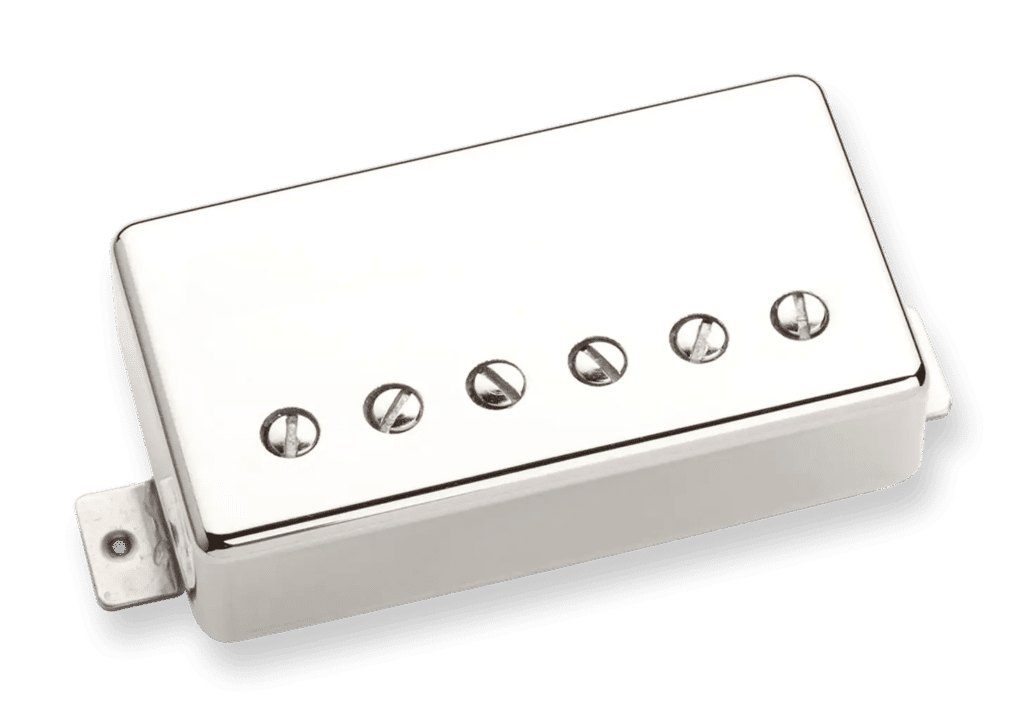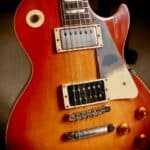You’re thinking about swapping the pickups of your guitar. Hey! Maybe you’re even building your dream ax or having it built by some amazing luthier…
But what is the best humbucker for your YOU?
In this article, we’ll lay out everything that there’s to know about some of the top contenders in the search for that sweet classic tone.
After that, we’ll put their specs side to side so you can see for yourself what are the tradeoffs you’ll be facing when your choose.
Finally, we’ll try to give you some hints about which one of these pickups would be the best for you.
If you’re in a hurry, here’s this article in a nutshell:
The main differences between Seth Lovers, ’57 Classics, and Pearly Gates are their output and their wiring. Pearly Gates have the lower output where ’57 Classics have the highest. The 2 Seymour Duncan ones come with 4 conductor wiring which makes possible coil splitting. Seth Lovers are the only ones not wax potted.
Let’s get to it!
Pearly Gates’ main features

Our first contender on the Seymour Duncan corner is the Pearly Gates pickup. A fan favorite without a doubt.
As the manufacturer claims on its website, the Pearly Gates humbuckers capture all the mojo of the original pickups from Billy Gibbons ‘59 Les Paul. It’s a P.A.F. style pickup hand built in Santa Barbara.
As for the Pearly Gates specs:
| Specs | Pearly Gates |
| Neck pickup output | 7.30k |
| Bridge pickup output | 8.10k |
| Magnet | Alnico 2 |
| Wiring | 4 conductor, shielded |
| Type | Passive |
| Wax potted | Yes |
Seth Lovers’ main features

Our second contenders on the Seymour Duncan side are the Seth Lovers. Another highly regarded piece of music history.
These pickups are named after the actual inventor of the hum-canceling pickups (or humbuckers) and claim to keep the tradition alive.
The Seth Lovers are also manufactured in Santa Barbara, following its creator’s original specs. Even going to the lengths of having the same factory that built the original PAF bobbins mold for Gibson build theirs.
Seymour Duncan offers 2 versions of these pickups a vintage-correct single conductor push-back braided lead wired one, and a 4-conductor more modern option.
The specs for the Seth Lovers are:
| Specs | Seth Lovers |
| Neck pickup output | 7.40k |
| Bridge pickup output | 8.30k |
| Magnet | Alnico 2 |
| Wiring | 1 conductor braided shield / 4 conductor, shielded |
| Type | Passive |
| Wax potted | Yes |
’57 Classics’ main features

And now, from the Gibson corner comes the ‘57 Classic. Their version of the P.A.F. pickup that became a legend with the golden era Les Pauls.
The ‘57 Classic claims to recreate that original sound at its best.
This model was firstly made available in 1990 and is said to provide a warm, full tone with a balanced response.
The main features of the ‘57 Classics are:
| Specs | ‘57 Classics |
| Neck pickup output | 7.50k |
| Bridge pickup output | 7.50k |
| Magnet | Alnico 2 |
| Wiring | 2 conductor |
| Type | Passive |
| Wax potted | Yes |
’57 Classics Plus’ main features

Under the Umbrella of the ‘57 Classic, Gibson also offers the ‘57 Classic plus.
This alternative model offers higher output, exactly as some of the most iconic late 1950’s bridge P.A.F. pickups did.
The specs for the ‘57 Classics Plus are as follows:
| Specs | ‘57 Classics Plus |
| Neck pickup output | |
| Bridge pickup output | 8.30k |
| Magnet | Alnico 2 |
| Wiring | 2 conductor |
| Type | Passive |
| Wax potted | Yes |
’57 Classic vs. ’57 Classic Plus
The main difference between these 2 versions is that the ‘57 Classics Plus are slightly overwound offering a higher output.
This feature is sought after mostly in bridge pickups.
Apart from this, and the price (the Plus are a bit more expensive), they’re the same pickups.
Are the ’57 Classic neck and bridge pickups the same?
There’s actually no ‘57 Classic bridge or neck, there’s only one ‘57 classic.
This pickup is well-suited to be used in any of those two positions. Particularly if you want to match it with another humbucker or single-coil.
It will work great in an HSS configuration for instance, as a bridge pickup, of course.
The main usage of this pickup, though, tends to be in the neck position.
The common practice is to have a pickup with a higher output in the bridge than in the neck. But that’s not the law and nobody compels you to do that.
It all comes down to a matter of taste.
How should I match the ’57 Classics and the ’57 Classics Plus?
What Gibson recommends, and actually does in their Traditional line of Les Pauls is matching a ‘57 Classic Plus in the bridge with a ‘57 Classic in the neck.
This makes for the most common configuration using these two versions of the same pickup and also what, maybe accidentally, the late 1950’s Les Pauls had in terms of pickup outputs.
Main differences between Pearly gates, Seth Lovers & ’57 Classics
And here’s what we promised. If you’re trying to decide between one of these pickups, maybe it will help you to see them one next to each other.
In the following table we will try to make sense of the slight spec differences between them:
| Specs | Pearly Gates | Seth Lovers | ‘57 Classics | ‘57 Classics Plus |
| Neck pickup output | 7.30k | 7.40k | 7.50k | |
| Bridge pickup output | 8.10k | 8.30k | 7.50k | 8.30k |
| Magnet | Alnico 2 | Alnico 2 | Alnico 2 | Alnico 2 |
| Wiring | 4 conductor, shielded | 1 conductor braided shield / 4 conductor, shielded | 2 conductor | 2 conductor |
| Type | Passive | Passive | Passive | Passive |
| Wax potted | Yes | No | Yes | Yes |
Is it clearer now?
Probably not, but let’s talk about it.
Which ones should you get?
Answering this question is indeed hard.
We could easily say that it’d be best if you tried every single one of these on your guitar and made your choice then.
That’s pretty much impossible or extremely inconvenient for most people.
It’d be wrong for us also to point you to specific tone sensations that we might feel by listening to online samples. You should do that by yourself and be aware that every aspect of the sound chain matters in defining the output.
From your speakers to the mic or preamp recording the audio in the sample to YouTube compression, to the guitar being used in the test against yours. Everything would influence your hearing experience.
We can talk about features. Known features and use cases of them.
Which one is more like an original P.A.F.?
Every single one of them, or maybe none.
How’s that?
When the P.A.F. humbucker was introduced it was a very artisanal piece of gear. Every unit was hand-wound and there was an extremely large variance between units. This impacted tone of course.
So what’s the P.A.F. sound then? The one single original pickup you like the most? The average of all of them? Just a few cherry-picked ones?
I’m sorry but we can’t give you specific answers.
What we can say is that these models do their best to get close around to what are perceived to be the original specs.
Every one of these models is a little different and will have a personality, but so did the ‘50s P.A.F. from batch to batch.
Wax potting
Wax potting is the process of submerging the pickup in liquid wax so that when it sets it binds all the internal components so they would not be as susceptible to vibrations which result in microphonics that generate feedback.
Some people say unpotted pickups have a particular character to them. What we would say is that if you play with mid to heavy gain at high volumes, maybe you should think about wax potted pickups.
If you’re more into clean tones and you don’t crank the amp to 11 every time, maybe try out the Seth Lovers.
Conductor quantity and coil-splitting
Coil splitting is the ability to “turn off” one of the coils and achieve a more single-coil-esque sound. The outcome is not the same as a single coil but it gets closer.
4 conductor pickups make it easier to install coil-splitting capabilities in your instrument.
If you’re building an HSS strat or want some more flexibility of sound with a light mod on your guitar, go for any of the Seymour Duncans.
Aesthetics
This might not be game-breaking but Pearly Gates come with more color options.

Hello there, my name is Ramiro and I’ve been playing guitar for almost 20 years. I’m obsessed with everything gear-related and I thought it might be worth sharing it. From guitars, pedals, amps, and synths to studio gear and production tips, I hope you find what I post here useful, and I’ll try my best to keep it entertaining also.





